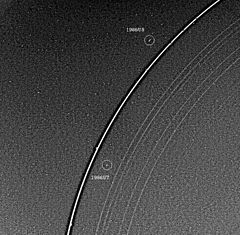Ophelia (maan)
 From Wikipedia (Af) - Reading time: 3 min
From Wikipedia (Af) - Reading time: 3 min
 Die ontdekkingsfoto van Ophelia (bo) deur Voyager 2. | |
| Ontdekking | |
|---|---|
| Ontdek deur | Richard J. Terrile / Voyager 2 |
| Datum | 20 Januarie 1986 |
| Wentelbaaneienskappe | |
| Wentelbaanradius | 53 763,390 ± 0,847 km[1] |
| Wentelperiode | 0,37640039 ± 0,00000357 d[1] |
| Gem. omwentelingspoed | 10,39 km/s |
| Baanhelling | 0,10362 ± 0,055°[1] |
| Satelliet van | Uranus |
Fisiese eienskappe |
|
| Afmetings | 54 × 38 × 38 km[2] |
| Gem. radius | 21,4 ± 4 km[2][3][4] |
| Oppervlakte | ~6 600 km² |
| Volume | ~41 000 km³ |
| Massa | ~5,3×1016 kg |
| Gem. digtheid | ~1,3 g/cm³ (aangeneem)[3] |
| Oppervlak- aantrekkingskrag | ~0,0070 m/s² |
| Ontsnapping- snelheid | ~0,018 km/s |
| Rotasieperiode | Sinkronies[2] |
| Ashelling | Nul[2] |
| Temperatuur | ~64 K |
Ophelia is ’n maan van Uranus. Dit is op 20 Januarie 1986 ontdek op foto's deur Voyager 2 en het die voorlopige naam S/1986 U 8 gekry.[5] Die naam "Ophelia" kom van die dogter van Polonius in William Shakespeare se Hamlet. Dit is ook bekend as Uranus VII.[6]
Beskrywing
[wysig | wysig bron]Ophelia is nie weer opgespoor totdat die Hubble-ruimteteleskoop dit in 2003 waargeneem het nie.[7][8] Baie min is daaroor bekend, buiten sy wentelbaan,[1] radius van 21 km[2] en geometriese albedo van 0,08.[7] Op die Voyager 2-foto's lyk dit langwerpig, met sy hoofas wat na Uranus wys.
Ophelia is die buitenste herdersmaan vir Uranus se ε-ring.[9] Sy wentelbaan is binne Uranus se radius vir sinkroniese wentelbane en neem dus langsamerhand af weens gety-invloede.[2]
Verwysings
[wysig | wysig bron]- ↑ 1,0 1,1 1,2 1,3
Jacobson, R. A. (1998). "The Orbits of the Inner Uranian Satellites From Hubble Space Telescope and Voyager 2 Observations". The Astronomical Journal. 115 (3): 1195–1199. Bibcode:1998AJ....115.1195J. doi:10.1086/300263.
{{cite journal}}: Ongeldige|ref=harv(hulp) - ↑ 2,0 2,1 2,2 2,3 2,4 2,5 Karkoschka, Erich (2001). "Voyager's Eleventh Discovery of a Satellite of Uranus and Photometry and the First Size Measurements of Nine Satellites". Icarus. 151 (1): 69–77. Bibcode:2001Icar..151...69K. doi:10.1006/icar.2001.6597.
- ↑ 3,0 3,1 "Planetary Satellite Physical Parameters". JPL (Solar System Dynamics). 24 Oktober 2008. Besoek op 12 Desember 2008.
- ↑ Williams, Dr. David R. (23 November 2007). "Uranian Satellite Fact Sheet". Nasa (National Space Science Data Center). Besoek op 12 Desember 2008.
- ↑ Smith, B. A. (27 Januarie 1986). "Satellites and Rings of Uranus". IAU Circular. 4168. Besoek op 31 Oktober 2011.
- ↑ "Planet and Satellite Names and Discoverers". Gazetteer of Planetary Nomenclature. USGS Astrogeology. 21 Julie 2006. Besoek op 6 Augustus 2006.
- ↑ 7,0 7,1 Karkoschka, Erich (2001). "Comprehensive Photometry of the Rings and 16 Satellites of Uranus with the Hubble Space Telescope". Icarus. 151 (1): 51–68. Bibcode:2001Icar..151...51K. doi:10.1006/icar.2001.6596.
- ↑ Showalter, M. R.; Lissauer, J. J. (3 September 2003). "Satellites of Uranus". IAU Circular. 8194. Besoek op 31 Oktober 2011.
- ↑
Esposito, L. W. (2002). "Planetary rings". Reports on Progress in Physics. 65 (12): 1741–1783. Bibcode:2002RPPh...65.1741E. doi:10.1088/0034-4885/65/12/201.
{{cite journal}}: Ongeldige|ref=harv(hulp)
Eksterne skakels
[wysig | wysig bron]- Ophelia Geargiveer 1 Augustus 2007 op Wayback Machine by Nasa se Solar System Exploration
- Uranus' Known Satellites (deur Scott S. Sheppard)
 Hierdie artikel is vertaal uit die Engelse Wikipedia
Hierdie artikel is vertaal uit die Engelse Wikipedia
Licensed under CC BY-SA 3.0 | Source: https://af.wikipedia.org/wiki/Ophelia_(maan)5 views | Status: cached on November 21 2024 12:12:09↧ Download this article as ZWI file
 KSF
KSF